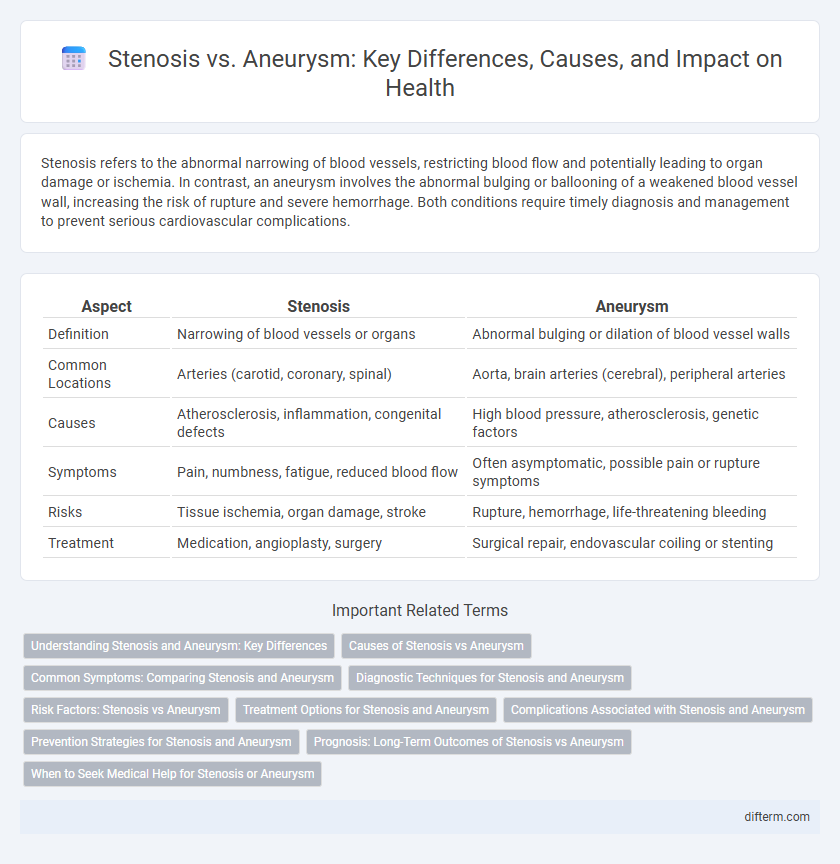Stenosis refers to the abnormal narrowing of blood vessels, restricting blood flow and potentially leading to organ damage or ischemia. In contrast, an aneurysm involves the abnormal bulging or ballooning of a weakened blood vessel wall, increasing the risk of rupture and severe hemorrhage. Both conditions require timely diagnosis and management to prevent serious cardiovascular complications.
Table of Comparison
| Aspect | Stenosis | Aneurysm |
|---|---|---|
| Definition | Narrowing of blood vessels or organs | Abnormal bulging or dilation of blood vessel walls |
| Common Locations | Arteries (carotid, coronary, spinal) | Aorta, brain arteries (cerebral), peripheral arteries |
| Causes | Atherosclerosis, inflammation, congenital defects | High blood pressure, atherosclerosis, genetic factors |
| Symptoms | Pain, numbness, fatigue, reduced blood flow | Often asymptomatic, possible pain or rupture symptoms |
| Risks | Tissue ischemia, organ damage, stroke | Rupture, hemorrhage, life-threatening bleeding |
| Treatment | Medication, angioplasty, surgery | Surgical repair, endovascular coiling or stenting |
Understanding Stenosis and Aneurysm: Key Differences
Stenosis involves the narrowing of blood vessels or other tubular structures, leading to restricted blood flow and potential organ damage. Aneurysm is characterized by an abnormal bulging or ballooning of a weakened vessel wall, increasing the risk of rupture and internal bleeding. Distinguishing these vascular conditions is crucial for targeted treatment strategies and effective management of cardiovascular health risks.
Causes of Stenosis vs Aneurysm
Stenosis is primarily caused by the chronic buildup of plaque due to atherosclerosis, leading to the narrowing of blood vessels and restricted blood flow. Aneurysm results from the weakening of the arterial wall, often triggered by high blood pressure, genetic factors, or trauma, causing abnormal vessel dilation. Both conditions are influenced by risk factors such as smoking, hypertension, and aging, but their underlying pathological mechanisms differ significantly.
Common Symptoms: Comparing Stenosis and Aneurysm
Stenosis typically presents with symptoms such as pain, numbness, or tingling due to narrowed blood vessels restricting blood flow, while aneurysms often manifest as pulsating lumps or sudden severe pain caused by the vessel wall's dilation and potential rupture. Both conditions may result in dizziness, headaches, or neurological deficits if affecting critical arteries. Early detection through imaging techniques like MRI or ultrasound is crucial to managing the risks associated with these vascular abnormalities.
Diagnostic Techniques for Stenosis and Aneurysm
Diagnostic techniques for stenosis primarily include Doppler ultrasound, which assesses blood flow velocity, and angiography, offering detailed vascular imaging to identify arterial narrowing. Aneurysms are typically diagnosed using computed tomography angiography (CTA) or magnetic resonance angiography (MRA), enabling precise visualization of arterial wall dilation and potential rupture risk. Both conditions may also require echocardiography when involving cardiac vessels to evaluate structural damage and guide treatment strategies.
Risk Factors: Stenosis vs Aneurysm
Stenosis risk factors include high blood pressure, atherosclerosis, and diabetes, which contribute to artery narrowing and reduced blood flow. Aneurysm risk factors involve hypertension, smoking, genetic disorders like Marfan syndrome, and age-related vessel wall weakening, increasing the chance of vessel rupture. Both conditions share hypertension as a common risk factor but differ significantly in their pathophysiology and specific contributing factors.
Treatment Options for Stenosis and Aneurysm
Treatment options for stenosis often involve angioplasty with or without stent placement to widen narrowed arteries and improve blood flow. In contrast, aneurysm management may require surgical repair such as clipping or endovascular coiling to prevent rupture and hemorrhage. Medication therapies like antihypertensives and anticoagulants are commonly used adjunctively in both conditions to control symptoms and reduce risks.
Complications Associated with Stenosis and Aneurysm
Stenosis often leads to complications such as reduced blood flow, ischemia, and increased risk of heart attack or stroke due to arterial narrowing. Aneurysm complications include vessel rupture, internal bleeding, and potential life-threatening hemorrhagic stroke, especially when the aneurysm wall weakens and bursts. Both conditions require prompt diagnosis and management to prevent severe cardiovascular events and improve patient prognosis.
Prevention Strategies for Stenosis and Aneurysm
Preventing stenosis involves managing risk factors such as high blood pressure, high cholesterol, and smoking through a healthy diet, regular exercise, and medication adherence to maintain arterial health. In contrast, aneurysm prevention emphasizes controlling hypertension and avoiding tobacco use, combined with regular imaging screenings for high-risk individuals to detect arterial bulging early. Both conditions benefit from lifestyle modifications, including weight management and stress reduction, to minimize vascular damage and enhance overall cardiovascular resilience.
Prognosis: Long-Term Outcomes of Stenosis vs Aneurysm
Stenosis often results in restricted blood flow, leading to chronic ischemia and an increased risk of heart attack or stroke, with prognosis heavily dependent on severity and timely intervention. Aneurysms pose a risk of rupture, causing life-threatening hemorrhage, and their long-term outcomes vary based on size, location, and prompt surgical management. Both conditions require ongoing monitoring and management to improve survival rates and reduce morbidity.
When to Seek Medical Help for Stenosis or Aneurysm
Seek immediate medical attention if experiencing symptoms such as severe chest pain, sudden weakness, numbness, difficulty speaking, or loss of vision, which may indicate a worsening stenosis or a ruptured aneurysm. Regular monitoring through imaging tests like ultrasound, CT, or MRI is crucial for individuals diagnosed with stenosis or aneurysm to prevent complications. Early intervention reduces the risk of stroke, organ damage, or life-threatening bleeding associated with these vascular conditions.
Stenosis vs Aneurysm Infographic

 difterm.com
difterm.com